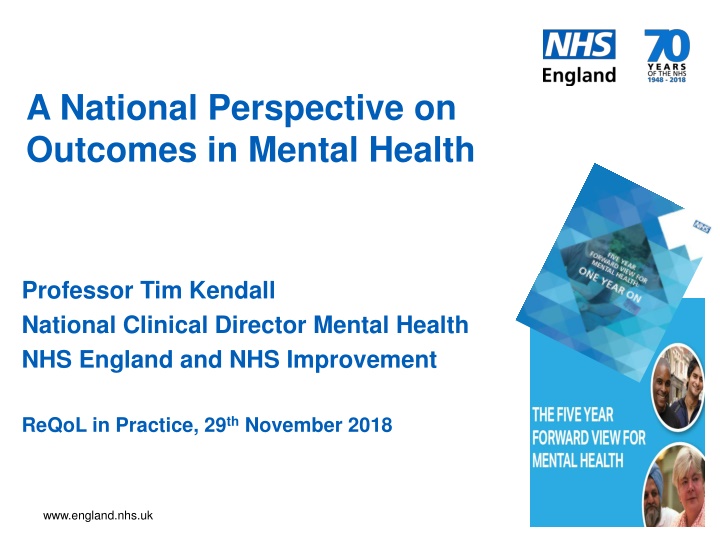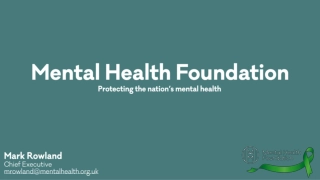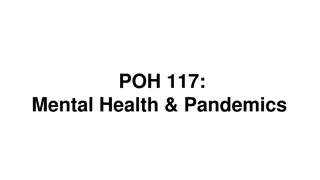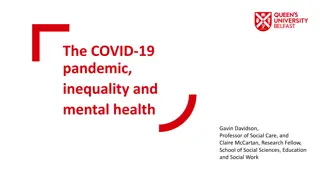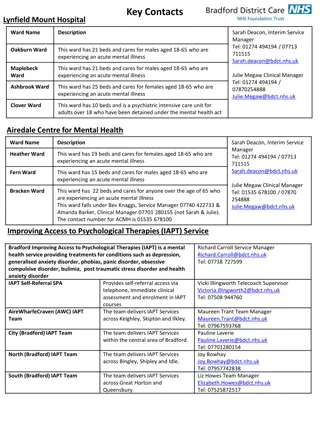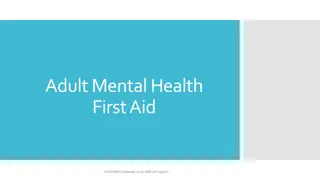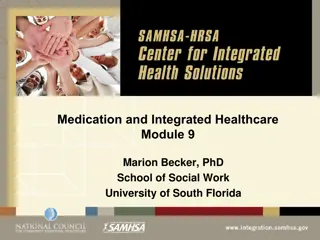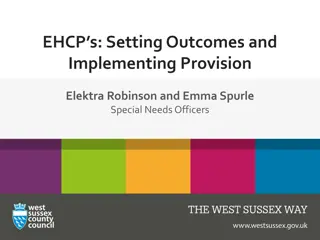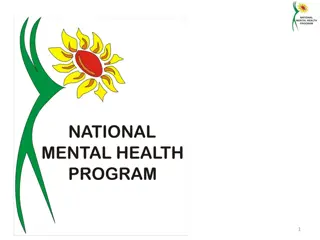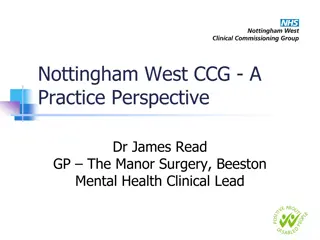Enhancing Mental Health Outcomes in Long-Term Conditions through IAPT Services
IAPT services focus on measuring outcomes on a session-by-session basis to ensure equitable use and monitor progress towards recovery. By including those with long-term conditions (LTCs), these services aim to address under-representation, improve outcomes, and reduce healthcare costs. Through patient vignettes and data analysis, the impact of IAPT-LTC services on recovery rates, healthcare utilization, and condition management is evident, demonstrating the effectiveness and potential benefits for individuals with LTCs.
Download Presentation

Please find below an Image/Link to download the presentation.
The content on the website is provided AS IS for your information and personal use only. It may not be sold, licensed, or shared on other websites without obtaining consent from the author.If you encounter any issues during the download, it is possible that the publisher has removed the file from their server.
You are allowed to download the files provided on this website for personal or commercial use, subject to the condition that they are used lawfully. All files are the property of their respective owners.
The content on the website is provided AS IS for your information and personal use only. It may not be sold, licensed, or shared on other websites without obtaining consent from the author.
E N D
Presentation Transcript
A National Perspective on Outcomes in Mental Health Professor Tim Kendall National Clinical Director Mental Health NHS England and NHS Improvement ReQoL in Practice, 29th November 2018 www.england.nhs.uk 1
Outcome measures in IAPT Routine outcome measurement on session by session basis is a key characteristic of IAPT services Outcomes recorded in 98% of cases (pre-IAPT 38%) Strict recovery criteria (both the anxiety and depression must reduce below threshold) Publicly reported data increases transparency Outcome measurement allows: Ensure equitable use of IAPT services Monitor and support the delivery of NICE-recommended care Provide information to the IAPT worker on progress Help people to chart their progress towards recovery Enhance engagement in collaborative decision-making and treatment reviews Support supervision Enhance the overall quality and cost-effectiveness of services www.england.nhs.uk 2
Outcome measures in IAPT-LTC Why focus on people with long term conditions? 1. Fairness Currently under-represented. 28% of people treated in IAPT services but 40% of cases in the community. 2. Great prospects for patients and their families The 2016/17 IAPT annual report from NHS Digital data shows outcomes have traditionally been poorer for people with LTCs (46% vs 51% recovery in LTC vs non-LTC) 3. Economic sense for the NHS Psychological therapy reduces physical healthcare costs by average of 20% (meta-analysis of 91 studies) Patient Vignette S, a forty year old female was referred to the IAPT-LTC service by their GP due to anxiety related to their long term condition, a respiratory disorder. At assessment, S recorded 8 on the PHQ-9, 11 on the GAD-7, W&SAS 25. Following 6 sessions at Step 2 S reached recovery recording a PHQ-9 of 1, 3 on the GAD-7 and 8 on the W&SAS. S completed CSRI s, (Client Service Receipt Inventory) reporting nil usage of A&E, zero hospital admissions and zero ambulance call outs but reported significant reduction in usage of other physical health services. Initial evaluations from early implementer sites show: 50% recovery rate achieved for patients in the IAPT-LTC pathway in most sites Reductions of primary care appointment utilisation demonstrated universally Reductions shown across the wider system particularly in reported days off sick Where increases in utilisation have occurred this is recognised as being a positive demonstration of condition management Variation in where return on investment can be achieved between pathways The total of GP visits fell from 2 in the period before treatment commencing to 1 in the following 2 CSRI, with the same pattern occurring for Non GP contacts. Usage of practice nurse increased slightly between CSRI 1 and CSRI 3 due to routine reviews. A wave 1 early implementer site has demonstrated reductions in healthcare utilisation across the following pathways- Appointment usage 1st and 2nd CSRI Cardiovascular GP Practice Nurse Physio- therapy Specialist Nurse (Cardiac etc) -95% Doctor (other than GP) -87% A&E Hospital Inpatient Admissions Ambulance Usage between -85% -85% -89% -86% -90% -91% -79% -67% -73% -97% -67% -80% -96% -63% -76% -81% -77% -86% -84% -77% -83% -83% -36% -61% -83% -57% -75% -83% +47% -44% Diabetes Respiratory www.england.nhs.uk All Pathways 3
Driving an outcome focus The structured assessment benefits recovery Does not impede treatment or burden staff Value to patient and system is clear Clinical value Results fed back to clinicians for local service improvement Commissioners and policy makers can assess performance and value Feedback and monitoring Stronger outcome data Data on outcomes is valid and reliable Data can be benchmarked Data can be used to guide care individual care decisions, service improvement, improved commissioning, wider system planning www.england.nhs.uk 4
Outcomes work stream 18/19 Children and young people Early intervention psychosis Perinatal National metric of reliable improvement in symptoms and functioning 2018/19 is a shadow year to - Support improvement in the use and reporting of the metric Test the metric for robustness Aim to report in the MHSDS from March 2019 Outcome measures have been defined HoNOS QPR DIALOG Working group established to identify barriers to outcomes collection and to propose solutions for better collection to inform service improvement The RCPsych launched Framework for Routine Outcome Measures in Perinatal Psychiatry a Framework for Routine Outcome Measures in Perinatal Psychiatry on 13th November which included recommendations around parental mental health and parent-infant relationship quality NHS England have established an expert reference group - and are working with partners to ensure the framework is successfully implemented in specialist teams through the development of an implementation manual and a series of 12 regional training workshop Framework for Routine Outcome Measures in Perinatal Psychiatry Framework for Routine Outcome Measures in Perinatal Psychiatry www.england.nhs.uk 5 Developing case studies of good practice in all areas
CYP MH Outcomes metric CYP reliable improvement in symptoms and functioning across CYP services (we are also measuring movement towards goals and will be reporting this alongside the metric) Paired outcomes are essential to understand the benefit that children and young people are getting from the services they receive. Without two observations on a specific measure it is impossible to assess change. The measures of change support young people to track their progress. Support for the metric from across the system and by young people and parents and carers has been confirmed through engagement with the Royal College of Psychiatrists, Royal College of Nurses, the BCP and YoungMinds. 2018/19 Shadow year Testing and refining the indicator; Building provider awareness of the indicator and responsibilities to report; Aim to drive up data quality and completeness ahead of April 2019 Over 1000 people, including children and young people and parents/carers, completed a consultation on the use of outcome measures. 50% Support 44% 42% 45% 41% 40% Monthly analysis of outcomes data in the MHSDS, being fed back to providers Regular Webinars to address queries well attended with high engagement from stakeholders Regional workshops in progress 37% 36% 40% 35% 34% 35% 30% 25% 20% 15% 10% Where are we now? In the first four months of implementation of the metric, the number of providers submitting paired scores to the MHSDS has increased significantly from 20 to 35. The steady percentage of paired scores through this rapid increase, supports the robustness of the indicator. 5% 0% Percent of those above clinical cut off with a paired assessment score Percent with paired assessment that reliably improved April '18 May '18 June '18 July '18 Caveat: Data is experimental and may not be complete www.england.nhs.uk Advising on application in other areas e.g. Perinatal MH 6
Early Intervention in Psychosis Background The EIP Access and Waiting time standard specified HoNOS and DIALOG and QPR to be collected as minimum, but services are struggling with this. We want to identify and find solutions to the problems with use and reporting of outcome measures. NHS England has formed a working group which met for the first time in October. The group identified three key themes. 1. Lack of understanding Need to improve the understanding of what an outcome is, how it is used in clinical practice, how an outcome measurement tool is administered including the timing of collection. 2. Data The flow of data to the MHSDS needs to be driven up. 3. Measuring clinically meaningful change The group will work to identify the best way to show clinically meaningful change in the three measures specified for use. www.england.nhs.uk 7
International Consortium For Health Outcomes Measurement (ICHOM) Delivering 4 standard sets of outcome measures by November 2019 Disorders related to substance use and addiction Psychotic disorders Depression/Anxiety/ OCD in CYP Personality disorders Delivering 2 additional standard sets of outcome measures by end of 2020 Neurodevelopmental disorders Eating disorders www.england.nhs.uk 8
Thank you! www.england.nhs.uk 9
